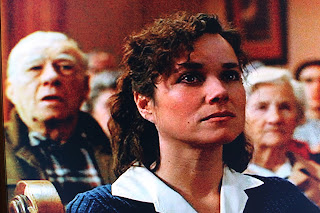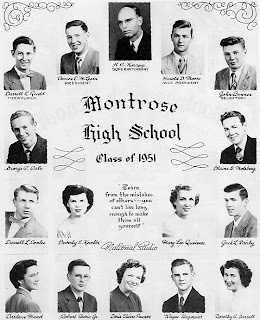In the game of basketball, both keeping time and score are a critical part of game operations. Without the clock, a game can not exist and without a score, a winner can not be determined. The same can be said about preserving a town's basketball heritage. One may delay keeping score or track of it's school's basketball records, stories, and traditions, but time will not. Over generations, history can be lost. But when preserved well, they can live on forever.
As we traveled north on Indiana State Road 25 in October 2004, we didn't know what to expect in the small town of Wingate, Ind. This was a spur of the moment decision as we were running ahead of schedule on our trip to Muncie to celebrate the 50th anniversary of Milan’s 1954 state championship game. Located in western Indiana, Wingate is only 6 miles off Interstate 74 near Crawfordsville. This part of the state is known as "The Cradle of Basketball" because the first eight state champions came from a three-county, 30-mile radius.
We had read about the early Wingate teams winning the state's first back-to-back Indiana state championships in 1913 and 1914, in only the third and fourth years after the state’s inaugural state tournament in 1911. Wingate even won a state and a national championship in 1920, but our true intention for the visit was to see the historic barn that once played host to Wingate’s home games in the first half of the 20th century.
 |
| Wingate Gymnasium on High Street |
The townspeople talked about how Stonebraker was considered the best basketball player in the United States. He led Wingate to their first two state titles and was a 3-time All-American at Wabash College in nearby Crawfordsville. The 6'3'' star once scored 80 points in a single game. Those at the cafe also told us that most opponents would pick him up at half-court because he was known to make any shot, anywhere on the floor.
 |
| Homer Stonebraker, team captain, is seated in the middle |
Stonebraker and the Wingate community were lucky to have had basketball. Since Wingate High School only had twelve boys in the entire school, they almost did not have enough players to field a team. In addition, Wingate did not have a gym, so they had to travel to nearby schools or play outdoors in order to practice. As a result, all games were played on the road from 1907 until 1925, which led to their infamous name, "Gymless Wonders". We were then told that the gym was only a block away, west on High Street, and that it was built in 1917 as a livery stable.
According to the article, The Cradle of Basketball, written by Jason Crowe in the 1995 issue of Indiana Basketball History Magazine, in 1925 the city purchased the livery stable and with some renovations, Wingate had its first and only gymnasium. The school rented the gym from the town for $3 for each practice and $6 for each game. Stoves heated the gym. Wingate played their home games in the barn, turned gym, until 1954 when Wingate closed its doors and consolidated with New Richmond to form Coal Creek Central High School.
When we pulled up to the historic barn, we were disappointed that the barn doors were closed. We walked around its perimeter and admired how well the barn had held up throughout the years. Time had been kind to it. You could drive by this piece of history and you would never know that basketball was once played behind the large white door. Inside, the dimensions of the court were only 60 x 28 feet and the roof peaked 20 feet in the center. The barn once displayed "Wingate Gymnasium" on its exterior front, but it has been painted over in recent years.
 |
| Old Wingate Gym in recent years |
When we pulled up to the historic barn, we were disappointed that the barn doors were closed. We walked around its perimeter and admired how well the barn had held up throughout the years. Time had been kind to it. You could drive by this piece of history and you would never know that basketball was once played behind the large white door. Inside, the dimensions of the court were only 60 x 28 feet and the roof peaked 20 feet in the center. The barn once displayed "Wingate Gymnasium" on its exterior front, but it has been painted over in recent years.
 |
| A new Wingate sign proclaiming State Champs |
This hidden gem caught my attention because who would expect this type of invention and contribution to come from a town with less than 300 residents. I would soon learn that in 1934, Radio repairman, Lee Haxton, was assisted by Roy MeHarry, to build the first electric basketball scoreboard in the country, which was used in Wingate Gym. Haxton focused on the mechanical parts and MeHarry arranged the electrical circuits.
Haxton would pass away in 1938, but MeHarry would live to see a movie about a small Indiana town basketball team winning the one-class state championship. Not only did he see the movie, Hoosiers, he was also in the movie. A portion of the movie was filmed in New Richmond, just a few miles northeast of Wingate. New Richmond became the fictional town, Hickory. MeHarry also traveled to Knightstown to play the role of the scorekeeper for the Hickory home games. You can also see him behind Myra Fleener (actress Barbara Hershey) in the church scene where the town meets to dismiss coach Norman Dale. MeHarry passed away in 2000.
 |
| MeHarry operating the scoreboard in the movie Hoosiers |
 |
 |
| MeHarry (behind Hershey) casting a vote during the town gathering |
If you're wondering what happened to the nation's first electrical basketball scoreboard once used in the Wingate Gym, travel to the Indiana Basketball Hall of Fame in New Castle, Ind. You'll see the scoreboard hanging on the wall. It looks as it did when operated in Wingate's gym. As for the old Wingate gym, it is also a timeless piece of history as well. The gym will remain a symbol of the early basketball years for generations to come.
After leaving Wingate, I couldn't help but think how lucky we were to stop into the cafe to get a brief history lesson, but more importantly, I felt very pleased that members of the Wingate community kept record of their team's heritage and helped illustrate the basketball history that commenced in this region. Time changes things, but one thing that will not change is Wingate's place in Indiana basketball history. Those who appreciate local history, like our family, could not have walked into a better place.
 |
| Wingate's scoreboard at the Indiana Basketball Hall of Fame |



































